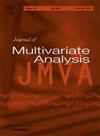Graph-constrained analysis for multivariate functional data
IF 1.4
3区 数学
Q2 STATISTICS & PROBABILITY
引用次数: 0
Abstract
The manuscript considers multivariate functional data analysis with a known graphical model among the functional variables representing their conditional relationships (e.g., brain region-level fMRI data with a prespecified connectivity graph among brain regions). Functional Gaussian graphical models (GGM) used for analyzing multivariate functional data customarily estimate an unknown graphical model, and cannot preserve knowledge of a given graph. We propose a method for multivariate functional analysis that exactly conforms to a given inter-variable graph. We first show the equivalence between partially separable functional GGM and graphical Gaussian processes (GP), proposed recently for constructing optimal multivariate covariance functions that retain a given graphical model. The theoretical connection helps to design a new algorithm that leverages Dempster’s covariance selection for obtaining the maximum likelihood estimate of the covariance function for multivariate functional data under graphical constraints. We also show that the finite term truncation of functional GGM basis expansion used in practice is equivalent to a low-rank graphical GP, which is known to oversmooth marginal distributions. To remedy this, we extend our algorithm to better preserve marginal distributions while respecting the graph and retaining computational scalability. The benefits of the proposed algorithms are illustrated using empirical experiments and a neuroimaging application.
多变量函数数据的图约束分析
该手稿考虑了多元功能数据分析,在表示其条件关系的功能变量之间使用已知的图形模型(例如,大脑区域级fMRI数据与大脑区域之间预先指定的连接图)。用于分析多元函数数据的函数高斯图模型(GGM)通常对未知的图模型进行估计,不能保留给定图的知识。我们提出了一种多元泛函分析方法,它完全符合给定的变量间图。我们首先展示了部分可分泛函高斯过程(GGM)和图形高斯过程(GP)之间的等价性,GP最近被提出用于构造保留给定图形模型的最优多元协方差函数。理论联系有助于设计一种新的算法,该算法利用Dempster的协方差选择来获得图形约束下多元函数数据的协方差函数的最大似然估计。我们还证明了在实践中使用的泛函GGM基展开的有限项截断等价于已知具有过光滑边缘分布的低秩图形GP。为了解决这个问题,我们扩展了我们的算法,以更好地保留边缘分布,同时尊重图和保留计算可扩展性。所提出的算法的好处是用经验实验和神经成像应用说明。
本文章由计算机程序翻译,如有差异,请以英文原文为准。
求助全文
约1分钟内获得全文
求助全文
来源期刊

Journal of Multivariate Analysis
数学-统计学与概率论
CiteScore
2.40
自引率
25.00%
发文量
108
审稿时长
74 days
期刊介绍:
Founded in 1971, the Journal of Multivariate Analysis (JMVA) is the central venue for the publication of new, relevant methodology and particularly innovative applications pertaining to the analysis and interpretation of multidimensional data.
The journal welcomes contributions to all aspects of multivariate data analysis and modeling, including cluster analysis, discriminant analysis, factor analysis, and multidimensional continuous or discrete distribution theory. Topics of current interest include, but are not limited to, inferential aspects of
Copula modeling
Functional data analysis
Graphical modeling
High-dimensional data analysis
Image analysis
Multivariate extreme-value theory
Sparse modeling
Spatial statistics.
 求助内容:
求助内容: 应助结果提醒方式:
应助结果提醒方式:


